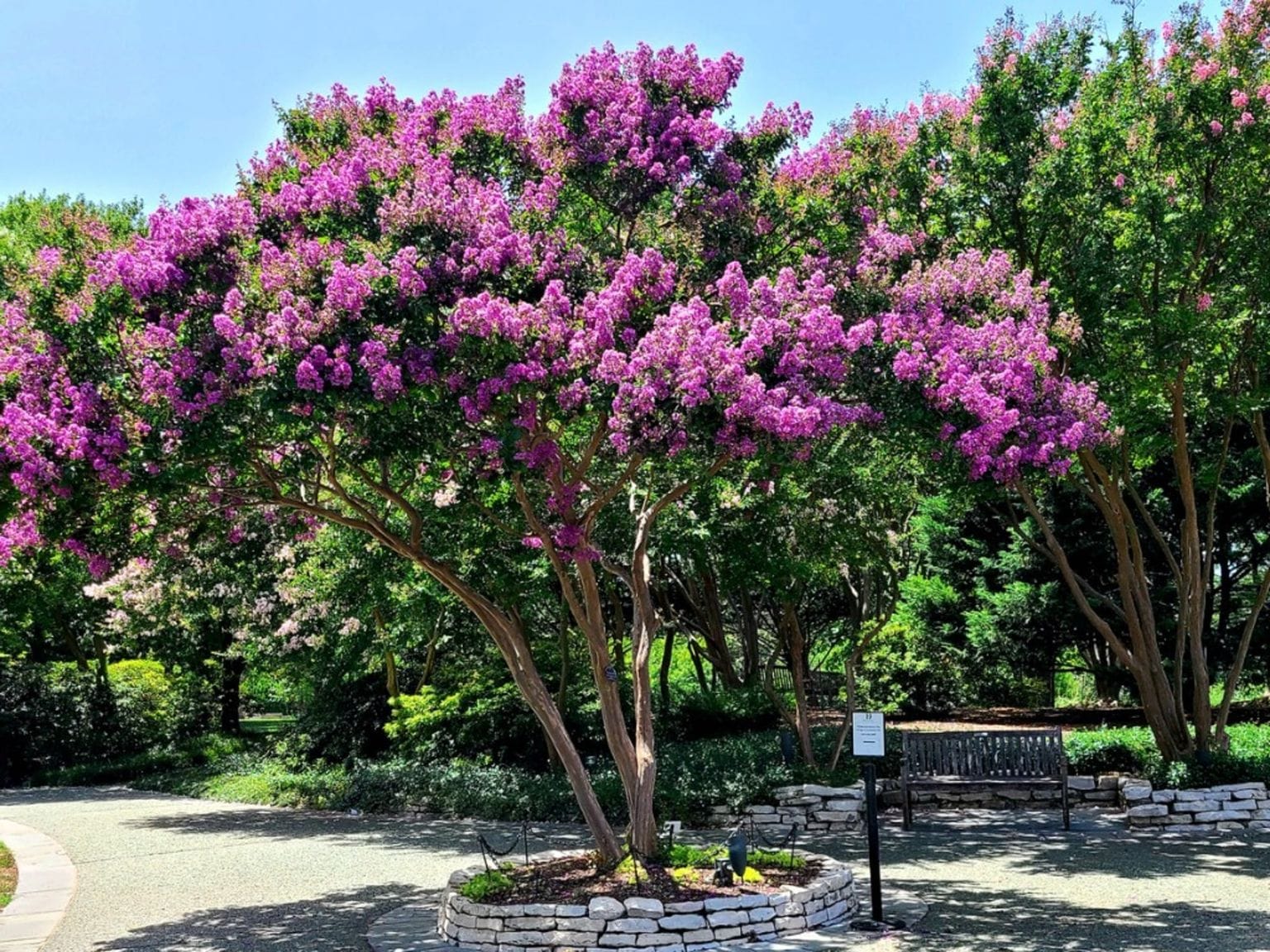Crepe Myrtles: A Symphony of Color from Summer to Fall. Curious about adding these vibrant, long-blooming beauties to your landscape? This comprehensive guide covers everything you need to know about crepe myrtle care, from planting and pruning to choosing the perfect variety for your space. Whether you’re a seasoned gardener or just starting out, we’ll equip you with the knowledge to cultivate thriving crepe myrtles that will grace your garden with beauty for years to come.
Understanding the Crepe Myrtle
Before we dive into the specifics of care, let’s get acquainted with the crepe myrtle itself. Understanding its origins and characteristics will provide a solid foundation for successful cultivation.
Botanical Classification and Origins
- Botanical Name: Lagerstroemia (approximately 50 species)
- Family: Lythraceae (loosestrife family)
- Native Range: Indian subcontinent, Southeast Asia, Northern Australia, and parts of Oceania. Naturalized in the Deep South of the United States.
This diverse genus encompasses a range of sizes and forms, from graceful shrubs to majestic trees. Their adaptability has allowed them to flourish in various climates around the world.
Growth Habits and Characteristics
Crepe myrtles are deciduous, meaning they shed their leaves in the fall, revealing their striking, exfoliating bark, which provides winter interest. This characteristic, combined with their vibrant summer blooms and often brilliant fall foliage, makes them a valuable asset for multi-season interest in the landscape. They range in size from dwarf varieties, suitable for containers and small gardens, to larger tree forms that can become the focal point of a yard. This diversity allows gardeners to select the perfect crepe myrtle to fit their specific needs and aesthetic preferences.
Cultivating Crepe Myrtle: A Step-by-Step Guide
Now that we’ve explored the background of crepe myrtles, let’s delve into the practical aspects of their care. These resilient plants are relatively low-maintenance once established, but a few key practices will ensure they thrive.
Planting Your Crepe Myrtle
- Timing: Spring is the ideal time to plant crepe myrtles, giving them a full growing season to establish themselves before winter.
- Sunlight: Crepe myrtles are sun worshippers, requiring at least six hours of direct sunlight daily for optimal blooming. A sunny, south-facing location is often ideal.
- Soil: Well-drained soil is crucial. Amend heavy clay soils with organic matter like compost or well-rotted manure to improve drainage and aeration. While they tolerate a range of soil pH levels, slightly acidic conditions are generally preferred.
- Spacing: Consider the mature size of your chosen variety when planting. Provide adequate space for growth to avoid overcrowding.
Watering and Fertilizing
- Watering: While drought-tolerant once established, regular watering is essential, especially during dry periods and the first year after planting. Water deeply but infrequently, allowing the soil to dry out slightly between waterings. This encourages deep root growth.
- Fertilizing: Crepe myrtles are not heavy feeders. A balanced fertilizer applied in spring is usually sufficient. Avoid over-fertilizing, as this can lead to excessive leaf growth at the expense of flowers.
The Art of Crepe Myrtle Pruning
Pruning is perhaps the most debated aspect of crepe myrtle care. Proper pruning enhances both the tree’s form and its flowering potential, while improper pruning—often referred to as “crepe murder”—can severely diminish its beauty.
- Timing: Late winter or early spring, before new growth begins, is the best time to prune.
- Technique: Remove dead, damaged, or crossing branches. Thin out crowded areas to improve air circulation. You can also shorten branches to shape the tree and encourage more blooms. However, avoid excessive pruning, which can result in unattractive, knobby growth and reduced flowering. For more detailed information, explore resources on advanced pruning techniques.
Exploring Crepe Myrtle Varieties
One of the most exciting aspects of growing crepe myrtles is the sheer diversity of varieties available. From dwarf shrubs perfect for containers to towering trees that command attention, there’s a crepe myrtle for every garden.
Popular Cultivars
Some popular cultivars include:
- ‘Natchez’: A large tree with stunning white flowers and beautiful exfoliating bark.
- ‘Tuscarora’: A medium-sized tree with vibrant coral-pink blooms and excellent disease resistance.
- ‘Muskogee’: A medium to large tree with lavender-pink flowers.
- ‘Acoma’: A smaller tree or large shrub with white flowers and a compact growth habit.
- ‘Infinitini®’ series: A range of dwarf varieties suitable for smaller gardens and containers, with various flower colors.
- ‘Dynamite’: A small tree with fiery red blooms.
Beyond these popular choices, countless other cultivars exist, each offering unique characteristics in terms of size, bloom color, and growth habit. Exploring the diverse world of crepe myrtle varieties is a rewarding journey for any gardener. Explore the fascinating world of the flightless cormorant for another captivating species. Discover the resilient cupaniopsis anacardioides, a tree that thrives in diverse environments.
Addressing Pests and Diseases
While crepe myrtles are generally quite resilient, they can be susceptible to certain pests and diseases. Regular monitoring and prompt treatment are essential to maintain their health and vigor.
Common Problems
- Aphids: These tiny insects can infest crepe myrtles, causing distorted leaves and sticky honeydew, which can lead to sooty mold.
- Powdery Mildew: This fungal disease appears as a white, powdery coating on the leaves. It is especially prevalent in humid conditions.
- Japanese Beetles: These beetles can chew holes in the leaves, causing significant damage.
- Other Fungal Diseases: Various fungal diseases can affect crepe myrtles, causing leaf spots, cankers, and other problems.
Prevention and Treatment
- Proper air circulation: Adequate spacing between plants helps to reduce humidity and prevent fungal diseases.
- Fungicide treatments: Applying fungicides can prevent or control powdery mildew and other fungal issues.
- Insecticidal soap or horticultural oil: These can be used to control aphids and other insect pests.
Crepe Myrtles in the UK: A Special Consideration
Can you grow crepe myrtles in the UK? Yes, you can! Although typically associated with warmer climates, crepe myrtles can be successfully cultivated in the UK, particularly in the southern regions with milder microclimates. Hardy varieties like the Indiya Charms series are particularly well-suited to British gardens. Key considerations for UK gardeners include careful site selection for maximum sunlight, providing well-drained soil, and offering winter protection through mulching or wrapping.
The Downside of Crape Myrtles: A Balanced Perspective
While crepe myrtles offer undeniable beauty and ease of care, it’s important to consider potential drawbacks. Overuse in landscaping can contribute to monoculture, reducing biodiversity and increasing the risk of widespread pest and disease outbreaks. Their prolific blooms and seed pods can also create a mess, requiring regular cleanup. Finally, the sheer popularity of crepe myrtles can sometimes lead to a sense of aesthetic monotony in certain landscapes. Understanding these potential downsides allows gardeners to make informed decisions about incorporating crepe myrtles into their overall design, ensuring a balanced and thriving landscape.
Unlock Decades of Beauty with Proper Care
With proper care, a crepe myrtle can grace your garden for decades. By understanding their needs and providing the right conditions, you can unlock their full potential, enjoying their vibrant blooms, colorful foliage, and attractive bark year after year. As research continues, we may discover even more ways to nurture these remarkable trees and appreciate their unique beauty.
- The Eagle’s Nest: Exploring Hitler’s Mountain Retreat and the Beauty of the Bavarian Alps - November 15, 2024
- The Ultimate Guide to Fairbanks Post Offices & ZIP Codes - November 15, 2024
- Lilac-Breasted Roller (Coracias caudatus): An In-Depth Look at Its Life, Habitat, and Conservation - November 15, 2024















